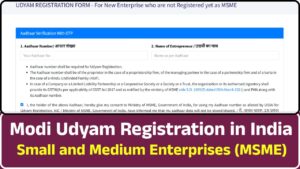Modi Udyam Registration in India
1. Introduction to Udyam Registration
Udyam Registration is an initiative by the Ministry of Micro, Small and Medium Enterprises (MSME) launched on 1st July 2020. It serves as a simplified, digital identity system for small businesses in India, replacing the earlier Udyog Aadhaar Memorandum (UAM) system.

It empowers small businesses to be formally recognized as MSMEs (Micro, Small, and Medium Enterprises) and avail benefits such as loans, subsidies, priority sector lending, and marketing assistance.
2. Evolution and Legal Framework
The Udyam Registration system was formed under the Micro, Small and Medium Enterprises Development Act, 2006, with major updates in 2020.
Timeline:
- 2006: MSMED Act introduced
- 2015: Udyog Aadhaar launched
- 2020: Udyam Registration replaces Udyog Aadhaar
3. Objectives and Importance
- Provide a unique identity to MSMEs
- Enable transparent data integration with GST and PAN databases
- Help in policy formulation through real-time analytics
- Streamline government benefits like subsidies, interest rebates, tenders
- Empower small businesses through recognition and formalization
4. Eligibility Criteria
Businesses across all sectors are eligible, including:
- Proprietorship
- Partnership Firms
- Limited Liability Partnership (LLP)
- Private & Public Companies
- Societies, Trusts, Self-Help Groups
They must meet the investment and turnover limits set for Micro, Small, and Medium Enterprises.
5. Classification of MSMEs
As per 2020 revision:
| Type | Investment Limit | Turnover Limit |
|---|---|---|
| Micro | ≤ ₹1 crore | ≤ ₹5 crore |
| Small | ≤ ₹10 crore | ≤ ₹50 crore |
| Medium | ≤ ₹50 crore | ≤ ₹250 crore |
6. Benefits of Udyam Registration
- Easy access to collateral-free loans
- Interest subsidy on overdraft facilities
- Faster government approvals
- Reduced electricity bills
- Protection against delayed payments
- ISO certification reimbursement
- Easier bank loans & credit guarantees
- Market support through exhibitions
- Priority in government procurement
- Exemptions under direct tax laws
7. Documents and Data Required
- Aadhaar Number (mandatory)
- PAN Card of entity
- Bank account details
- Business details (address, activity)
- Investment and turnover data
- GSTIN (if available)
- NIC Code for business activity
8. Step-by-Step Online Registration Process
- Visit https://udyamregistration.gov.in
- Choose “For New Entrepreneurs”
- Enter Aadhaar number and validate via OTP
- Enter PAN details
- Fill in business name, address, and activity
- Add bank account and classification details
- Select appropriate NIC Code
- Declare turnover and investment
- Submit the application
- Download the Udyam Certificate
9. Udyam Certificate and Udyam Number
- A 16-digit Udyam Registration Number is generated
- E.g., UDYAM-IN-XX-XXXXXXXX
- Udyam Certificate includes:
- Business name
- Address
- Enterprise type
- Classification (Micro/Small/Medium)
- Date of registration
10. Integration with PAN, GST & Other Portals
Udyam is auto-integrated with:
- Income Tax database (PAN validation)
- GSTIN (turnover confirmation)
- GeM portal for procurement
- TReDS for bill discounting
11. Role in Government Schemes
After registering, MSMEs can avail:
- PMEGP loan schemes
- Credit Guarantee Fund Scheme
- Zero Defect Zero Effect (ZED) Scheme
- Startup India
- Atmanirbhar Bharat packages
- Interest subvention schemes
12. Transition from Udyog Aadhaar to Udyam
Udyog Aadhaar holders must:
- Re-register on Udyam portal
- Old UAM registration was valid only till 31st December 2021
- Udyam enables more reliable tracking via PAN and GST
13. How to Update Udyam Details
Update Process:
- Login using Udyam Number and OTP
- Modify address, NIC code, classification, or contact info
- Changes in turnover and investment are updated automatically based on PAN/GST data
14. Challenges and Misconceptions
- Belief that Udyam registration requires fees (It’s completely free)
- Fraudulent agents charge money for free services
- Technical issues on the portal due to server load
- Confusion regarding correct NIC codes or enterprise classification
15. Udyam in Business Growth and Recognition
Udyam Registration allows MSMEs to:
- Participate in global trade fairs
- Apply for patents and trademarks with subsidies
- Get recognized for government-funded research and innovation
- Secure funding through venture capitalists who prefer formal businesses
16. Case Studies of Registered Enterprises
Example 1: Micro Garment Manufacturer
- Registered under Udyam
- Got access to Mudra loan
- Participated in MSME Expo
Example 2: Tech Startup (Medium Enterprise)
- Formalized via Udyam
- Received collateral-free loan under CGTMSE
- Gained priority in GeM portal procurement
17. Frequently Asked Questions
Q: Is Udyam Registration mandatory?
A: It’s voluntary but essential for accessing MSME benefits.
Q: Can a company without GST register?
A: Yes, but GSTIN is required for turnover-based verification.
Q: What is NIC Code?
A: It’s the National Industrial Classification code based on your activity type.
Q: Can I register more than one business?
A: Yes, each business must register separately.
18. Support and Contact
- Helpline: 1800 123 3468 (Toll-free)
- Email: [email protected]
- Portal: https://udyamregistration.gov.in
19. Common Mistakes to Avoid
- Entering wrong Aadhaar or PAN
- Using third-party sites that charge fees
- Not updating turnover or investment
- Ignoring NIC code classification
- Forgetting to download the Udyam Certificate
20. Conclusion
Udyam Registration is a powerful step for India’s growing micro and small business sector. It enables formalization, access to government support, and business growth. With a simple and free registration process, it provides recognition and endless opportunities to entrepreneurs across the country.
Whether you’re a startup, artisan, trader, or manufacturer, registering under Udyam is essential to unlock the full potential of your business.
